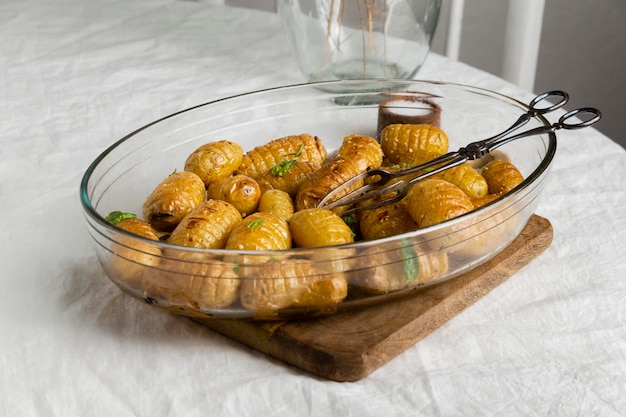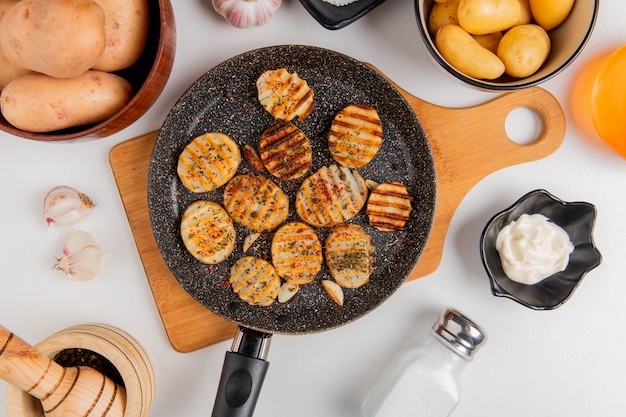sweet potatoes. They're everywhere, right? We all know they're good for us, packed with vitamins, fibre, and all that good stuff. But honestly, sometimes they feel a bit...well, ordinary. Bland, dry, and just not terribly exciting. But my fellow food enthusiasts, let me tell you: oven-baked sweet potatoes can be utterly divine! The key? It's all about mastering the technique. Think melt-in-your-mouth softness on the inside, paired with a crisp, caramelised exterior. Pure heaven.
I've spent years experimenting with different methods, testing out spices, and even trying some, well, let's just say "interesting" combinations (don't ask about the beetroot and cinnamon incident). Through all those triumphs and disasters, I've learned a thing or two about what really makes oven-baked sweet potatoes sing. So, gather 'round, because I'm about to share my wisdom with you. A good oven-baked sweet potato is a culinary masterpiece. It's a versatile side dish that elevates any meal and it's incredibly easy to make. Let's get started.
(Part 1) Choosing the Right Spuds

The Sweet Potato Family
Let's start by talking about the sweet potato itself. You might be surprised to learn that there's a whole family of them out there, each with its own unique flavour and texture. The most common ones you'll find in your local supermarket are the orange ones, the ones we'll be focusing on today. But did you know there are also purple sweet potatoes, white sweet potatoes, and even yellow ones? They all have their own distinct personalities, but the orange ones are the most versatile and generally a good place to start.
Finding the Perfect Spud
Now, when you're picking out your sweet potatoes, look for firm ones with smooth skin. Avoid any that feel soft or have bruises, as they might be past their prime. Aim for a spud that's about the same size as your fist – that's the sweet spot for even cooking. If you're feeling adventurous, smaller sweet potatoes are often a bit sweeter and cook quicker.
(Part 2) Preparing Your Spuds

Washing and Scrubbing
Once you've got your sweet potatoes, it's time to give them a good wash. You don't need to peel them, just scrub off any dirt or grit with a vegetable brush. If the skin is particularly tough, you can gently scrape it with a knife, but try not to remove too much – the skin adds flavour and texture to the roasted potato.
Cutting and Cubing
Now, time to cut your sweet potato into chunks. You can cut them into wedges, cubes, or even thin slices. Personally, I prefer to cut them into about 1-inch cubes – they cook evenly and are a good size for picking up. If you're using smaller sweet potatoes, you can leave them whole or cut them in half.
(Part 3) Getting Ready for the Oven

The Magic of Roasting
Okay, let's talk about the oven. This is where the magic happens. The heat from the oven allows the sweet potato to caramelise and develop that crispy exterior while staying tender on the inside. I prefer to roast my sweet potatoes on a baking sheet because it allows for even cooking and prevents them from steaming. You'll also want a good oven-safe rack to lift the sweet potatoes off the baking sheet. This ensures they don't get soggy and allows for better airflow around them.
The Secret Weapon: Olive Oil
Now for the secret weapon: olive oil. Drizzle a generous amount of olive oil over your sweet potato chunks. This will help them crisp up nicely and absorb the flavours of your seasonings. Make sure you coat the potatoes evenly so that they all cook to perfection.
(Part 4) Seasoning and Flavouring
Basic But Brilliant
Now comes the fun part – seasoning! You can get as creative as you like, but I always start with a good sprinkle of salt and pepper. These two simple ingredients bring out the natural sweetness of the sweet potato and add a touch of depth. You can also add a pinch of cayenne pepper for a bit of a kick.
Beyond the Basics: Herbs and Spices
But the possibilities don't end there! Experiment with all sorts of herbs and spices to create different flavour profiles. For a classic flavour, add some rosemary, thyme, or garlic powder. For a more exotic flavour, try cinnamon, ginger, cumin, or paprika. Personally, I love a combination of smoked paprika and a pinch of cayenne for a smoky, spicy flavour that really complements the sweetness of the potato.
A Pinch of Sweetness
You can even add a bit of sweetness to your sweet potatoes. A sprinkle of brown sugar, maple syrup, or honey will enhance the sweetness and create a caramel-like glaze. Just be careful not to overdo it, as you don't want to mask the natural sweetness of the potato.
(Part 5) The Baking Process
The Oven Temperature
Preheat your oven to 400 degrees Fahrenheit (200 degrees Celsius). This high temperature will help to caramelise the potatoes and ensure they cook through quickly.
The Baking Time
Spread your sweet potato chunks on a baking sheet and bake them for 20-25 minutes, or until they are tender and slightly caramelised. You'll know they're ready when they're fork-tender and have a slight browning on the outside.
The Importance of Turning
About halfway through the baking process, give the sweet potatoes a good toss to ensure they cook evenly on all sides. This will help them develop that crispy exterior we're aiming for.
(Part 6) The Finishing Touches
The Power of a Bit of Butter
Once your sweet potatoes are cooked, take them out of the oven and give them a final drizzle of olive oil. Then, add a generous dollop of butter to the baking sheet. This will melt and coat the potatoes, adding a rich and buttery flavour.
The Final Touch: Fresh Herbs
For a final touch of freshness, sprinkle some chopped fresh herbs over your roasted sweet potatoes. Parsley, chives, cilantro, or oregano work beautifully.
(Part 7) Serving and Storing
Serving Suggestions
roasted sweet potatoes are a perfect side dish for any meal. They're great with grilled meats, fish, or chicken. You can also add them to salads, soups, or stews for extra flavour and texture. And of course, they're absolutely delicious on their own, especially when sprinkled with a bit of salt and pepper.
Storage Tips
If you have any leftover roasted sweet potatoes, you can store them in an airtight container in the refrigerator for up to 3 days. They'll be just as delicious the next day and make for a quick and easy snack or side dish.
(Part 8) Oven-Baked sweet potato variations
Sweet and Savoury Combinations
Now, let's get a bit more adventurous with our oven-baked sweet potatoes. We can create some delicious variations by adding different flavours and textures to our base recipe.
sweet potato fries
Cut your sweet potatoes into thin fries, toss them with olive oil and spices, and bake them until crispy. You can even dip them in your favourite dipping sauce.
Sweet Potato and black bean salad
Roast your sweet potatoes with black beans, corn, and spices. Serve this salad with a tangy vinaigrette.
Sweet Potato and Kale Hash
Sauté some chopped kale with roasted sweet potatoes, onion, and garlic. Top with a fried egg for a hearty and healthy meal.
(Part 9) The Importance of Experimenting
The beauty of oven-baked sweet potatoes is that you can really experiment with different flavours and techniques. Don't be afraid to try new things and see what works best for you. There's no right or wrong way to do it, just have fun and enjoy the process.
(Part 10) FAQs
1. Can I use a microwave to cook sweet potatoes?
Yes, you can certainly microwave sweet potatoes. It's a much faster method than roasting, but it won't give you that crispy exterior. If you're looking for a quick and easy way to cook sweet potatoes, microwaving is a good option. Just pierce the sweet potato a few times with a fork to prevent it from exploding in the microwave. Cook on high power for about 5-7 minutes, or until tender.
2. How do I know when my sweet potatoes are done?
You’ll know your sweet potatoes are done when they’re fork-tender and have a slight browning on the outside. If you’re not sure, you can cut one open to check. If the inside is still hard, bake for a few more minutes.
3. What are some good toppings for oven-baked sweet potatoes?
The possibilities are endless! You can top your oven-baked sweet potatoes with anything you like. Here are a few ideas:
- Butter and salt and pepper
- Sour cream and chives
- Crumbled bacon and cheese
- Roasted chickpeas and tahini sauce
- Guacamole and salsa
4. Can I freeze roasted sweet potatoes?
Yes, you can freeze roasted sweet potatoes. Just let them cool completely, then place them in an airtight container in the freezer. They’ll keep for up to 3 months. To reheat, bake them in the oven at 350 degrees fahrenheit (175 degrees Celsius) for about 15-20 minutes, or until heated through.
5. What are some other ways to cook sweet potatoes?
There are many different ways to cook sweet potatoes. Here are a few other methods:
- Boiling: Boil peeled sweet potatoes until tender, about 15-20 minutes.
- Sautéing: Sauté diced sweet potatoes in butter or olive oil until tender, about 10-15 minutes.
- Mashed: Mash cooked sweet potatoes with butter, milk, and seasonings.
(Part 11) Sweet Potato – A culinary gem
There you have it, my friends. A guide to mastering the art of oven-baked sweet potatoes. I hope you've enjoyed my tips and tricks, and I encourage you to experiment with different flavour combinations. Don't be afraid to try something new and create your own signature sweet potato recipe. Remember, cooking is about having fun and exploring new flavours. So get out there and get creative with your sweet potatoes! Happy roasting.
Everyone is watching

How to Cook Frozen Lobster Tails Perfectly: A Step-by-Step Guide
RecipesLobster. Just the word conjures up images of lavish meals, special occasions, and a taste of luxury. But let's...

Pork Fillet Cooking Time: How Long to Cook It Perfectly
RecipesPork fillet, or tenderloin as it's sometimes called, is a real favourite in our house. It's so versatile, and...

Pigs in a Blanket Cooking Time: How Long to Bake for Perfect Results
RecipesAh, pigs in a blanket. Just the name conjures up images of those delightful little parcels of crispy pastry en...

The Ultimate Guide to Cooking Delicious Frankfurters
RecipesLet's face it, we all love a good frankfurter. It's a classic, simple, and always satisfying. But let's be rea...

Wolf Meat Recipes: A Guide to Cooking Wild Game
RecipesLet's be honest, you don't see wolf meat at your local butcher shop every day. It's a bit of a wild card, but ...
